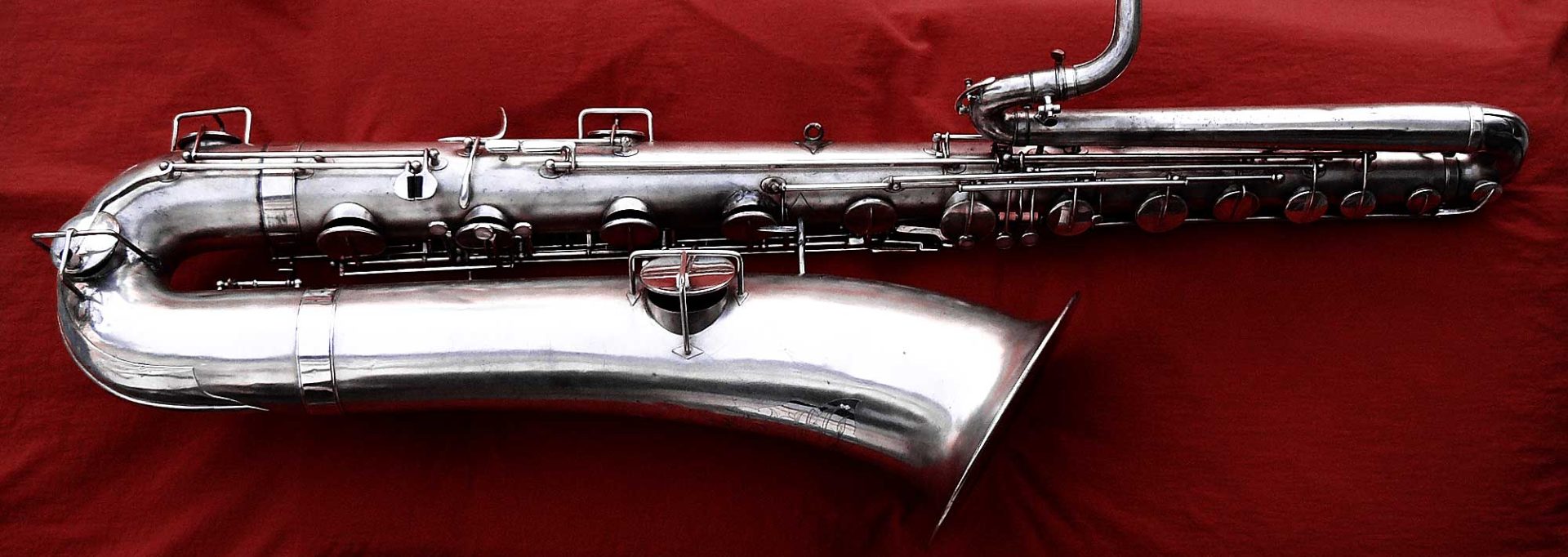Yesterday I spent nearly half of the day at my tech’s shop. I went to pick up my JK-stencilled Jubilee (Toneking) alto that David had just finished a restoration on, drop off a couple of horns for tweaking, and have him do some work on a couple of my other horns while I waited.
While I was there David dealt with the usual phone calls and walk-ins. One of the walk-ins is appropriate fodder for discussion here, since it involved baritone saxophones.
A teacher from a local school came in with 2 baritones that needed work. These were unfortunately the only baris the school had, and both were unplayable.
The first bari was an old Pan, which the school picked up from my old alma mater, Abby. At best it could be described as a P.O.S. It was most likely a P.O.S. already when Abby sold it. Now, it’s a higher mileage P.O.S.
Low Bb Bundy bari. Source: saxophophant on eBay.com
When I went to Abby, Bundy was the brand of the baritone saxophone the school had in its inventory. This Pan was likely a replacement, back in the day, for one of these Bundy baris. (Some quick research this morning indicates that these Pan saxophones, with a goat boy engraved on the bell, were stencil horns ordered by a now-defunct music store in Toronto, Ontario.)
The good baritone that this teacher brought in yesterday, was a Millennium. It’s obviously a Asian stencil horn, and a really cheaply made, P.O.S. horn at that.
The low C key guard on the Millennium needed to be resoldered, the high E key kept popping out, and most importantly, the left pinky cluster was :censor: -up to the point where it would no longer work. And these are just the highlights. The horn was a train wreck—although admittedly the Pan was in worse shape.
With Christmas concerts coming up, the students are practicing all the time, so the teacher was hoping David could get the horns back into playing condition in only a few days.
After the teacher was gone, I was talking to David about these new, Asian school horns. I mentioned that the only thing that’s good about them, is that they provide steady work for techs like him. However, for students they have to be frustrating as hell.
Source: metrognomemusic on eBay.com
While the pinkie clusters on the Bundys may have been pinkie busters, at least the horns were of a decent build quality. They took the abuse that school baritones always get, but kept right on going. They were not frustrating to play, because you were not constantly fighting the horn.
David told me that he is seeing this kind of situation all the time now. Schools just don’t have the money to buy decent baritones. What they end up settling for are cheap, Asian-made, P.O.S. horns that break down in no time at all.
This has to be really frustrating for students. You want to play baritone sax, but you end up with a sax that only plays semi-well part of the year. The rest of the year the horn is either unplayable, or in the shop for repairs. What do you do? Quit playing bari? Try to convince your parents to buy you one? Or save up enough money to pay for one yourself?
As a teacher I’ve seen the results that playing shitty horns has on students. It contributes towards the development of bad habits, frustration, and in worst case scenarios, quitting the instrument altogether. None of these are good outcomes in my opinion.
I was fortunate when I learned to play, that I had access to decent quality, student model saxophones. This was as true for the school horns I played, as it was for the saxophones my parents rented for me, and for the first sax I ever owned: an Orsi stencil horn.
I suspect that many of today’s students are not nearly as lucky as I was. Today’s students are far more likely to be learning on subpar horns.
Given how few of my cohort continued playing past high school graduation, I wonder if the decreased access to decent quality, student horns will result in an even greater number of students giving up their musical pursuits past high school?





I’ll tell you what I did when presented with unplayable instruments that were not on the repair list — I either figured out how to fix them (and we DID have pads and such laying around), or I found another instrument. With trumpets we often took the worst of the bunch and cannibalized them for parts to keep all the otherwise identical horns going. At least that way we only had one or two REALLY broken horns, and a bunch that worked. Of course this doesn’t work when the school only owns two and they’re not even the same.
Another thing we did was more practical — we stopped marching large and complex instruments like baritone saxophones and bass clarinets. You couldn’t hear them anyhow (at least not compared to, say, a baritone horn), and the weather wasn’t doing them any good. That’s with mild Southern California weather too, I can’t imagine the weather in BC would be any gentler on instruments! The fiberglass sousaphones and old beaten-up pea-shooter trombones were much more reliable in the rain and the cold, not to mention easier to hear.
We don’t march here in Canada. Schools don’t have marching bands. I think that’s an American thing. Even university bands don’t march.
Up here, the only bands that march are community bands, pipe bands, and specialized marching bands like drum and bugle corps.
No, these baris were just beaten to shit from classroom use. :beat: How sad is that!